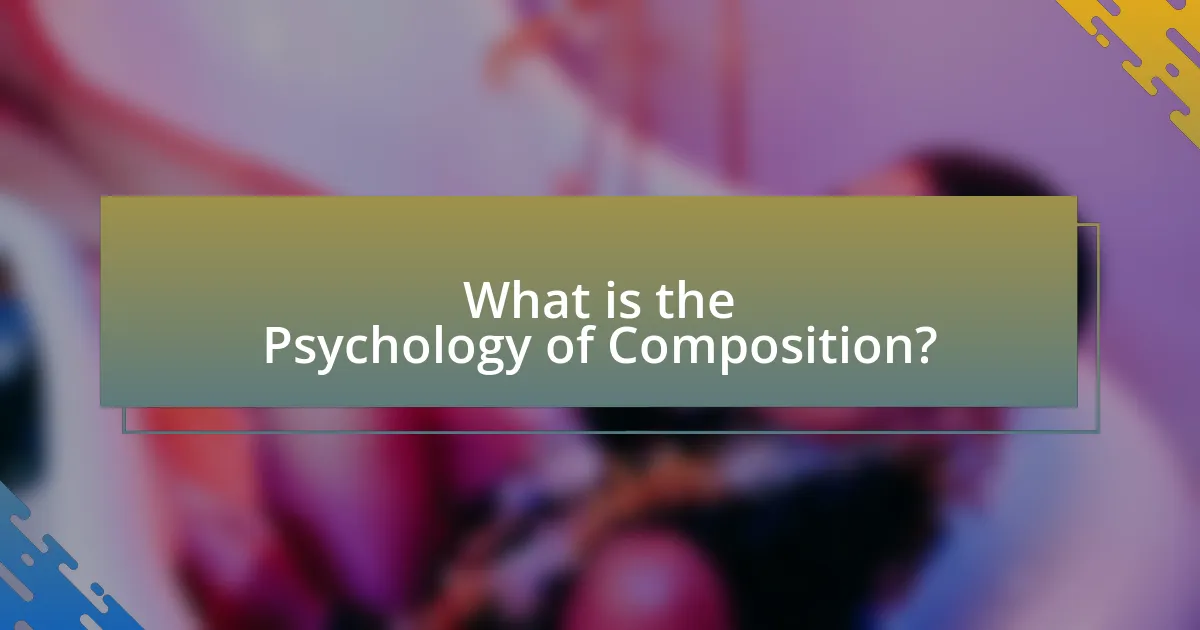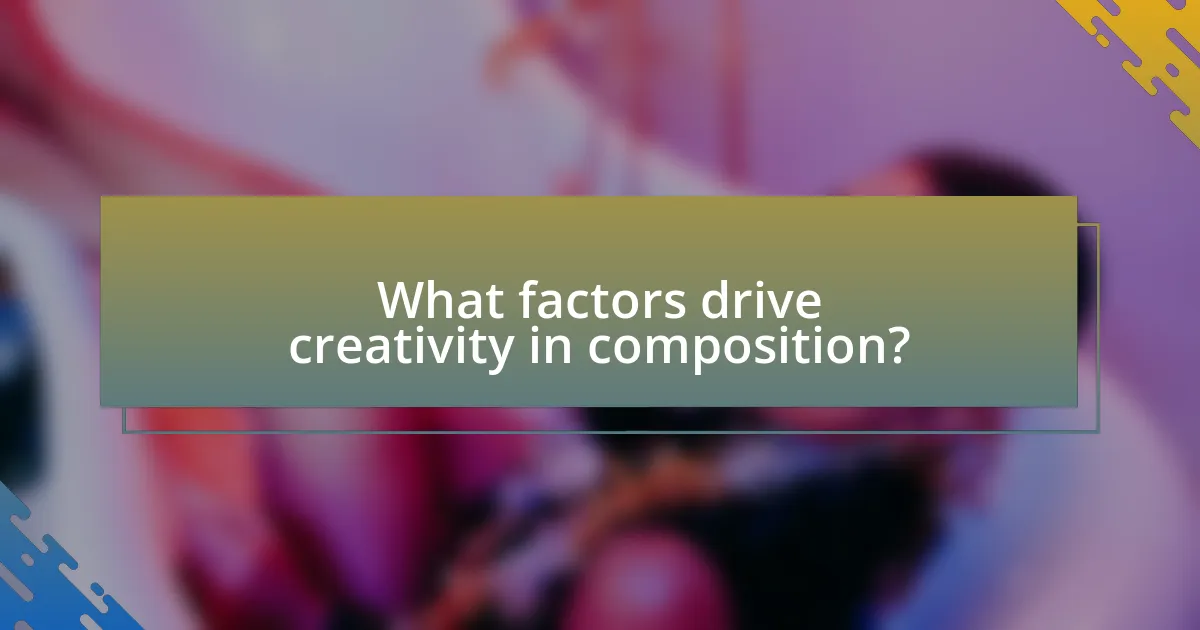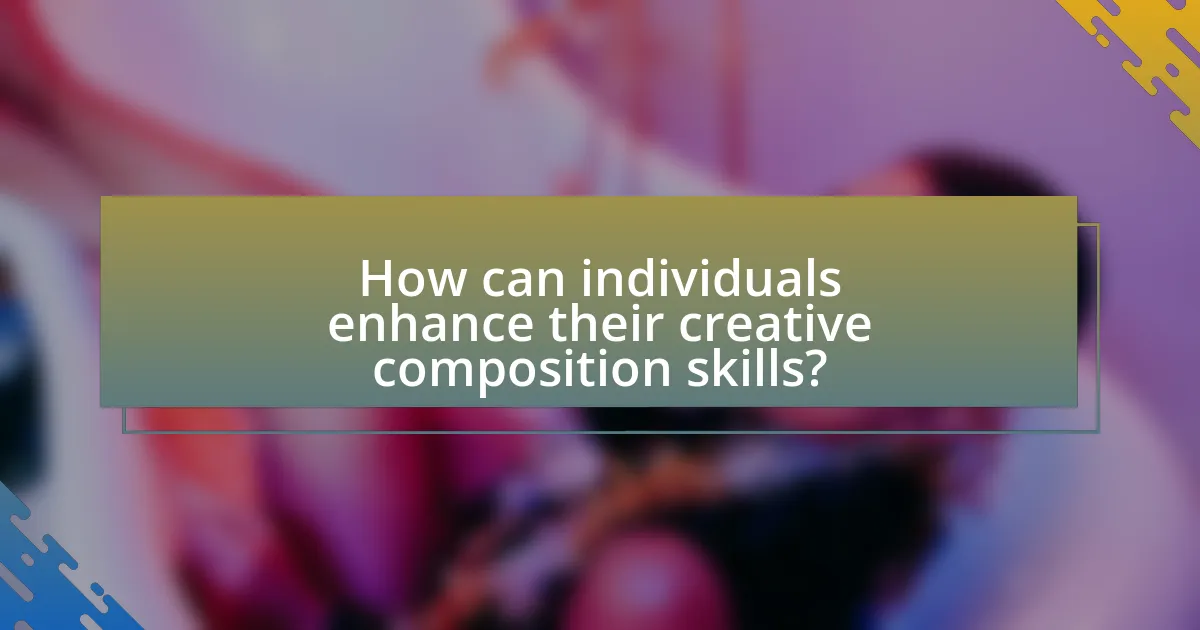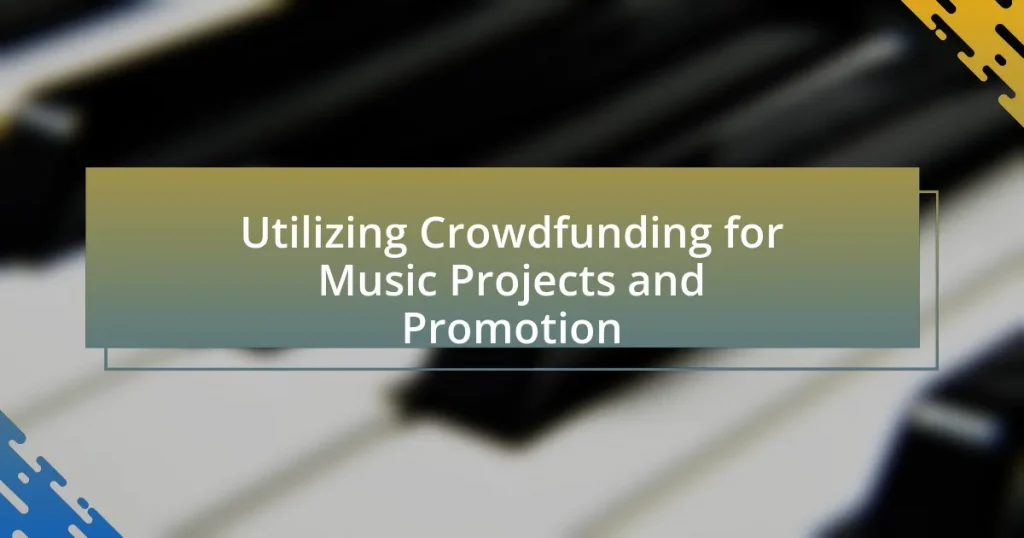The Psychology of Composition examines how cognitive processes, such as perception, emotion, and memory, influence the creation and arrangement of artistic works. This article explores the relationship between psychological theories and creativity, highlighting key models like the Geneplore Model and the Componential Theory of Creativity. It discusses how cognitive processes affect creative composition, the importance of intrinsic and extrinsic motivations, and the role of environmental factors in enhancing creativity. Additionally, it addresses common challenges faced in the creative process and offers practical strategies for improving creative composition skills.

What is the Psychology of Composition?
The Psychology of Composition refers to the study of how cognitive processes influence the creation and arrangement of artistic works. This field examines how factors such as perception, emotion, and memory affect an artist’s decisions during the composition process. Research indicates that understanding these psychological elements can enhance creativity and improve the effectiveness of artistic expression, as demonstrated by studies showing that artists often rely on mental imagery and emotional resonance to guide their compositional choices.
How does the psychology of composition influence creativity?
The psychology of composition significantly influences creativity by shaping how individuals organize their thoughts and ideas, which in turn affects their creative output. Research indicates that structured composition techniques, such as outlining and brainstorming, enhance cognitive processes, allowing for more innovative connections between concepts. For instance, a study published in the journal “Creativity Research Journal” by Runco and Acar (2012) found that individuals who employed systematic approaches to composition demonstrated higher levels of creative thinking compared to those who did not. This suggests that the mental frameworks established through composition psychology facilitate a more effective exploration of creative possibilities.
What are the key psychological theories related to creativity?
Key psychological theories related to creativity include the Geneplore Model, the Componential Theory of Creativity, and the Investment Theory of Creativity. The Geneplore Model, proposed by Finke, Ward, and Smith, emphasizes the interplay between generative and exploratory processes in creative thinking. The Componential Theory of Creativity, developed by Teresa Amabile, identifies three components: domain-relevant skills, creativity-relevant processes, and intrinsic motivation, which together foster creative performance. The Investment Theory of Creativity, articulated by Robert Sternberg and Todd Lubart, posits that creative individuals are like good investors who buy low and sell high in terms of ideas, suggesting that creativity involves risk-taking and the ability to recognize and capitalize on opportunities. These theories collectively provide a framework for understanding the cognitive and motivational factors that drive creativity.
How do cognitive processes affect the composition of creative works?
Cognitive processes significantly influence the composition of creative works by shaping how individuals generate ideas, solve problems, and express emotions. These processes, including perception, memory, and reasoning, enable creators to synthesize information and draw connections between disparate concepts, which is essential for innovation. For instance, research by Finke, Ward, and Smith in “Creative Cognition: Theory, Research, and Applications” demonstrates that cognitive flexibility allows individuals to adapt their thinking and explore multiple perspectives, leading to more original outcomes. Additionally, the role of working memory in holding and manipulating information is crucial for developing complex narratives or artistic compositions, as shown in studies linking working memory capacity to creative performance. Thus, cognitive processes are foundational to the creative process, directly impacting the quality and originality of the resulting works.
Why is understanding the psychology of composition important?
Understanding the psychology of composition is important because it informs how individuals create and interpret artistic works. This understanding allows creators to effectively engage their audience by leveraging cognitive and emotional responses elicited through composition techniques. Research indicates that elements such as balance, contrast, and focal points significantly influence viewer perception and emotional engagement, as demonstrated in studies on visual art and design. For instance, a study published in the journal “Psychology of Aesthetics, Creativity, and the Arts” by Silvia and Nusbaum (2011) highlights how compositional choices can enhance creativity and emotional resonance in artistic expression.
What impact does it have on artists and creators?
The impact on artists and creators is significant, as it influences their creative processes and the way they express their ideas. Research indicates that psychological factors, such as motivation and emotional state, directly affect artistic output and innovation. For instance, a study published in the Journal of Creative Behavior by Runco and Acar (2012) found that intrinsic motivation enhances creativity, leading to more original and high-quality work. Additionally, the environment in which artists create, including social interactions and feedback, shapes their artistic development and can either foster or hinder their creative expression.
How can it enhance the creative process in various fields?
It can enhance the creative process in various fields by providing structured frameworks that stimulate innovative thinking. For instance, techniques such as brainstorming, mind mapping, and design thinking encourage collaboration and diverse perspectives, which are essential for generating unique ideas. Research by the American Psychological Association indicates that environments fostering open communication and idea sharing significantly boost creativity, as seen in creative industries like advertising and design. These methods not only facilitate the generation of ideas but also help in refining and developing them into viable solutions, demonstrating their effectiveness across disciplines.

What factors drive creativity in composition?
Creativity in composition is driven by several key factors, including individual experiences, environmental influences, and cognitive processes. Individual experiences shape a person’s unique perspective and emotional responses, which can enhance originality in their work. Environmental influences, such as exposure to diverse cultures, collaboration with others, and access to resources, can stimulate new ideas and approaches. Cognitive processes, including divergent thinking and problem-solving skills, enable individuals to generate multiple solutions and explore various possibilities in their compositions. Research by Csikszentmihalyi highlights that creativity emerges from the interaction of personal traits, social context, and cultural factors, reinforcing the importance of these elements in driving creativity in composition.
How do intrinsic and extrinsic motivations affect creativity?
Intrinsic motivation enhances creativity by fostering a genuine interest and enjoyment in the creative process, leading to more innovative outcomes. Research indicates that when individuals engage in activities for their own sake, such as personal satisfaction or curiosity, they are more likely to explore novel ideas and take creative risks. For example, a study by Amabile (1996) found that intrinsic motivation significantly correlates with creative performance in various domains, including art and science.
Extrinsic motivation, on the other hand, can either support or hinder creativity depending on its nature. When external rewards, such as money or recognition, are perceived as controlling, they may diminish intrinsic motivation and stifle creativity. Conversely, if extrinsic rewards are seen as supportive, they can enhance motivation and lead to increased creative output. For instance, research by Deci and Ryan (2000) highlights that extrinsic rewards can undermine intrinsic motivation when they are contingent on performance, but can also provide a boost when they affirm competence without controlling behavior.
In summary, intrinsic motivation generally promotes creativity by encouraging exploration and enjoyment, while extrinsic motivation can have mixed effects, either facilitating or inhibiting creative expression based on how it is perceived by the individual.
What role does intrinsic motivation play in the creative process?
Intrinsic motivation is crucial in the creative process as it drives individuals to engage in creative activities for the inherent satisfaction they provide, rather than for external rewards. Research indicates that when individuals are intrinsically motivated, they exhibit greater persistence, higher quality of work, and increased innovation. For instance, a study by Amabile (1996) published in the “Journal of Personality and Social Psychology” found that intrinsic motivation significantly enhances creativity by fostering a deeper engagement with the task at hand. This engagement leads to more original ideas and solutions, demonstrating that intrinsic motivation is a key factor in facilitating creativity.
How can extrinsic rewards influence creative output?
Extrinsic rewards can significantly influence creative output by providing motivation and enhancing performance. When individuals are offered tangible incentives, such as money or recognition, they may feel compelled to produce more innovative work to achieve those rewards. Research by Amabile et al. (1996) in “Assessing the Impact of Extrinsic Rewards on Intrinsic Motivation” indicates that while extrinsic rewards can boost initial creativity, they may also undermine intrinsic motivation over time, leading to a decrease in creative output if the focus shifts solely to the reward rather than the creative process itself. Thus, the relationship between extrinsic rewards and creativity is complex, with potential positive and negative effects depending on the context and the individual’s intrinsic motivation.
What environmental factors contribute to creativity?
Environmental factors that contribute to creativity include physical space, social interactions, and cultural influences. A stimulating physical environment, such as one with natural light, open spaces, and access to nature, has been shown to enhance creative thinking. For instance, a study published in the Journal of Environmental Psychology found that individuals working in environments with natural elements exhibited higher levels of creativity compared to those in sterile settings.
Social interactions also play a crucial role; collaboration and diverse perspectives can lead to innovative ideas. Research by the American Psychological Association indicates that teams with varied backgrounds produce more creative solutions than homogenous groups. Additionally, cultural influences, such as societal values that encourage risk-taking and experimentation, significantly impact creative output. Countries that prioritize innovation and artistic expression tend to foster higher levels of creativity among their populations.
How does the physical workspace impact creative thinking?
The physical workspace significantly impacts creative thinking by influencing mood, motivation, and cognitive function. Research indicates that environments with natural light, open spaces, and stimulating colors can enhance creativity by promoting a positive emotional state and reducing stress. For instance, a study published in the Journal of Environmental Psychology found that individuals working in spaces with natural elements reported higher levels of creativity and satisfaction compared to those in conventional office settings. Additionally, flexible workspaces that allow for movement and collaboration foster innovative thinking by encouraging interaction and the exchange of ideas among individuals.
What social influences can enhance or hinder creativity?
Social influences that can enhance creativity include collaboration, diverse perspectives, and supportive environments, while hindering factors consist of criticism, conformity, and lack of resources. Collaboration fosters idea exchange, leading to innovative solutions, as evidenced by studies showing that teams with diverse backgrounds generate more creative outcomes. Conversely, environments that emphasize conformity can stifle individual expression, reducing creative output, as demonstrated in research indicating that fear of negative evaluation can inhibit creative thinking.

How can individuals enhance their creative composition skills?
Individuals can enhance their creative composition skills by engaging in regular practice, exploring diverse perspectives, and seeking constructive feedback. Regular practice allows individuals to refine their techniques and develop a unique style, as evidenced by studies showing that consistent engagement in creative activities leads to improved skill levels. Exploring diverse perspectives, such as studying different genres or collaborating with others, fosters innovation and broadens creative thinking. Additionally, seeking constructive feedback from peers or mentors helps individuals identify areas for improvement and encourages growth, which is supported by research indicating that feedback is crucial for skill development in creative fields.
What techniques can be employed to boost creativity?
Techniques to boost creativity include brainstorming, mind mapping, and engaging in diverse experiences. Brainstorming encourages the generation of a large number of ideas without immediate judgment, fostering an open environment for creativity. Mind mapping visually organizes thoughts and concepts, allowing individuals to see connections and explore new ideas. Engaging in diverse experiences, such as traveling or learning new skills, exposes individuals to different perspectives and stimulates creative thinking. Research indicates that exposure to varied stimuli enhances cognitive flexibility, which is crucial for creative problem-solving.
How does brainstorming facilitate creative composition?
Brainstorming facilitates creative composition by generating a wide array of ideas in a collaborative environment. This process encourages participants to think freely and build upon each other’s thoughts, leading to innovative solutions and unique perspectives. Research indicates that brainstorming can enhance creativity by reducing the fear of judgment, which allows individuals to express unconventional ideas. A study published in the Journal of Creative Behavior found that group brainstorming sessions resulted in a 20% increase in idea generation compared to solitary brainstorming, demonstrating the effectiveness of collaborative creativity in composition.
What role does mindfulness play in enhancing creativity?
Mindfulness significantly enhances creativity by fostering a state of open awareness and reducing mental clutter. This practice allows individuals to access deeper levels of thought and inspiration, as evidenced by research conducted by Zabelina and Robinson (2010), which found that mindfulness meditation leads to increased divergent thinking, a key component of creative problem-solving. By promoting a non-judgmental awareness of thoughts and feelings, mindfulness enables individuals to explore new ideas without the constraints of self-criticism, thereby facilitating innovative thinking and creative expression.
What are common challenges faced in the creative process?
Common challenges faced in the creative process include mental blocks, fear of failure, and lack of inspiration. Mental blocks can hinder the flow of ideas, often stemming from self-doubt or external pressures. Fear of failure can prevent individuals from taking risks necessary for innovation, as evidenced by studies showing that anxiety can stifle creativity. Lack of inspiration often results from routine or burnout, which can diminish motivation and lead to stagnation in creative output. These challenges are well-documented in psychological research, highlighting the complex interplay between emotional states and creative performance.
How can fear of failure impact creative composition?
Fear of failure can significantly hinder creative composition by inducing anxiety and self-doubt in the creator. This psychological barrier often leads to avoidance behaviors, where individuals may procrastinate or abandon projects altogether due to the fear of not meeting their own or others’ expectations. Research indicates that high levels of anxiety can impair cognitive flexibility, which is essential for innovative thinking and problem-solving in creative tasks. A study published in the Journal of Creative Behavior found that individuals with a strong fear of failure reported lower levels of creative output and were less likely to take risks in their work, ultimately stifling their creative potential.
What strategies can help overcome creative blocks?
To overcome creative blocks, individuals can employ strategies such as setting specific goals, changing their environment, and practicing mindfulness. Setting specific goals helps to create a clear direction, which can reduce feelings of overwhelm and increase focus. Changing the environment, such as working in a different location or rearranging the workspace, can stimulate new ideas and perspectives. Practicing mindfulness techniques, like meditation or deep breathing, can enhance mental clarity and reduce anxiety, allowing for a more open flow of creativity. Research indicates that these strategies can effectively enhance creative output by fostering a conducive mental state and environment for idea generation.
What practical tips can improve creative composition?
To improve creative composition, writers should engage in regular brainstorming sessions to generate diverse ideas. This practice enhances creativity by allowing the exploration of various perspectives and concepts without immediate judgment. Research indicates that brainstorming can lead to a 20% increase in idea generation compared to solitary thinking. Additionally, setting specific constraints, such as word limits or thematic boundaries, can stimulate innovative thinking by forcing writers to think outside conventional frameworks. Studies show that constraints can enhance creativity by 30%, as they encourage problem-solving and resourcefulness. Finally, seeking feedback from peers can provide valuable insights and alternative viewpoints, further refining the composition process.
How can setting specific goals enhance creativity?
Setting specific goals enhances creativity by providing clear direction and focus, which can lead to more innovative outcomes. When individuals establish precise objectives, they create a framework that encourages exploration within defined parameters, allowing for deeper engagement with the creative process. Research by Locke and Latham (2002) indicates that specific and challenging goals lead to higher performance compared to vague or easy goals, as they motivate individuals to push their boundaries and think outside the box. This structured approach not only fosters a sense of purpose but also reduces ambiguity, enabling individuals to channel their creative energies more effectively.
What practices can foster a more creative mindset?
Engaging in diverse experiences fosters a more creative mindset. Research indicates that exposure to different cultures, ideas, and disciplines enhances cognitive flexibility, which is crucial for creative thinking. For instance, a study published in the journal “Creativity Research Journal” by researchers Baer and Kaufman found that individuals who engage in varied activities demonstrate higher levels of creativity. Additionally, practices such as brainstorming, mindfulness meditation, and collaborative problem-solving have been shown to stimulate creative thought processes by encouraging open-mindedness and reducing mental barriers.















